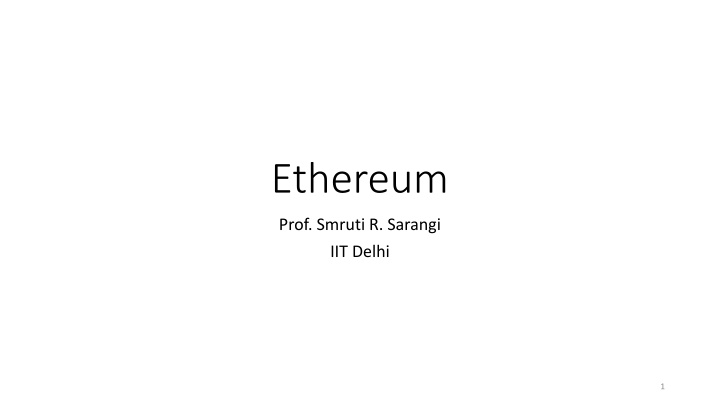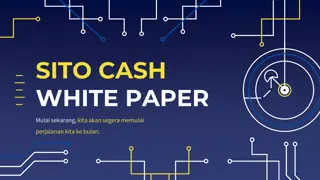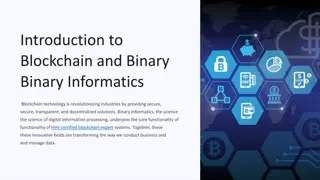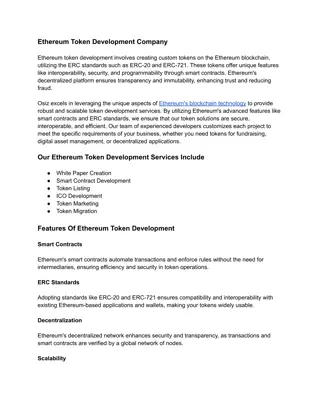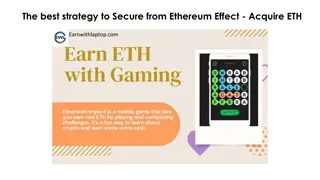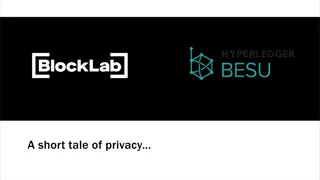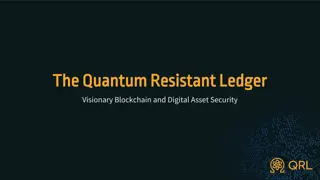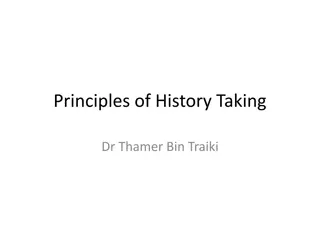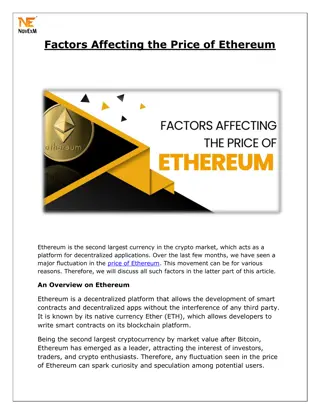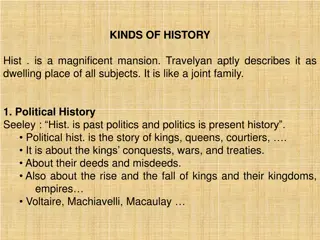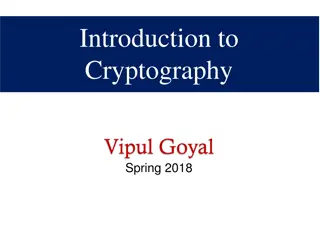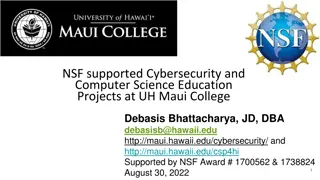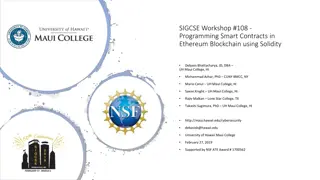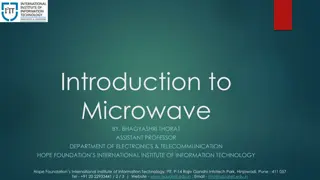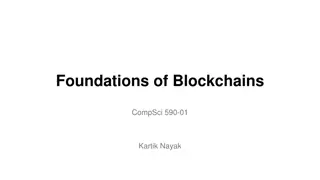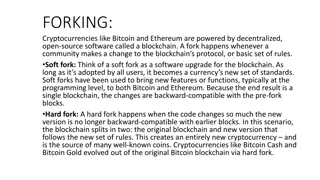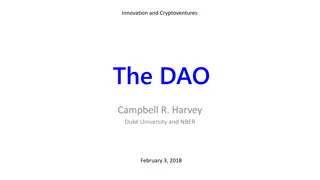Ethereum: History, Concepts, and Technology
This comprehensive guide delves into the history, core concepts, and technical aspects of Ethereum, the popular cryptocurrency platform. From the origins of proof of work to the creation of non-fungible tokens (NFTs), the content covers machine and world state, basic blockchain concepts, addresses, Merkle Patricia Tree, and more.
Download Presentation

Please find below an Image/Link to download the presentation.
The content on the website is provided AS IS for your information and personal use only. It may not be sold, licensed, or shared on other websites without obtaining consent from the author.If you encounter any issues during the download, it is possible that the publisher has removed the file from their server.
You are allowed to download the files provided on this website for personal or commercial use, subject to the condition that they are used lawfully. All files are the property of their respective owners.
The content on the website is provided AS IS for your information and personal use only. It may not be sold, licensed, or shared on other websites without obtaining consent from the author.
E N D
Presentation Transcript
Ethereum Prof. Smruti R. Sarangi IIT Delhi 1
History of Ethereum Dwork and Naor proposed the idea of proof of work way back in 1992 Vishnumurthy et al. [2003] used PoW to secure a currency. The basic idea is to make it very hard to generate fake currency. Bitcoin came in 2008 [Satoshi Nakamoto] We have seen a deluge of cryptocurrencies after that Ethereum came in 2013 (first proposed by Vitalik Buterin) It is much more than a digital currency. It allows users to run arbitrary code on a shared global state (allows all kinds of financial instruments) Second largest cryptocurrency in terms of market cap in 2018 (just behind Bitcoin) Extremely popular as of 2022. Adopted to create a large number of financial products. Also used to create Non Fungible Tokens (NFTs) for managing digital art and collectibles. Smart contracts 2
Machine State and World State World state Machines All the machines (nodes) are share a common world state. It is a shared state that is modified by transactions. Every machine has a private machine state. 3
Basic Concepts The blockchain starts with a genesis block. There are two kinds of functions applied to the world state State transition functions (transfer from account A to account B) Account creation transactions The built-in currency is in Ether ( ). The lowest denomination is a Wei. Multiplier Name 1 Wei 1012 1015 1018 Szabo Finney Ether 4
World State Addresses (160-bit ids) Account state The account states need to be maintained by each machine Preferably in a Merkle Patricia tree (MPT) This is the state database The contents of the root node are dependent on the state of the entire tree 5
What is a Merkle Patricia Tree (or Trie)? What is a Patricia trie? A prefix tree d a t d a o s t do as e o to te 6
Merkle Tree A tree of hashes The root represents the state of the entire tree. hash (hash(A), hash (B,C)) hash(A) hash (B,C) A B C 7
Merkle Patricia Tree The leaf nodes are <key, value> pairs The key can be the account id or the transaction id (or hashes of them) The key is used to traverse the MPT tree There are two kinds of internal nodes: branch node and extension node We traverse the MPT tree in terms of nibbles (4-bit quantities) A branch node can have 16 children (24= 16) The MPT discourages nodes with a single child. An extension node collapses a chain of nodes (stores all the nibbles beyond the position of the extension node) The full Merkle tree is traversed (DFS) once to create a root hash and then the root hash is updated incrementally. 8
Parts of the Account State Nonce #contract creations made or #transactions sent to an address Balance #Wei owned by an account storageRoot Root hash (256 bits) of the contents of the account. codeHash Hash of the EVM (Ethereum Virtual Machine) code 9
Transactions data Message transfer (input byte array) Creation of a new account (contract creation) body Code that when a message is received Common Fields Nonce #transactions sent by the sender gasPrice #Wei per unit of gas (computational effort) gasLimit Maximum gas that can be spent for this transaction (paid up front) to Recipient of the message value Value to be transferred 10
The Block Contains a list of transactions + other information Concept of an ommer block Grand parent Parent Ommer Block 11
List of Fields in a Block Field Meaning parentHash Hash of the parent s block header ommersHash Hash of the list of ommers beneficiary Who gets the fees for successfully mining this block stateRoot transactionsRoot Root hash of the account state trie Root hash of the trie (that stores all the transactions in the block) receiptsRoot logsBloom Root hash of the trie that has all transaction receipts Bloom filter for all the log topics in the transaction logs 12
List of Fields in a Block II Field Meaning difficulty mining difficulty level of the block (function of the timestamp and difficulty of the previous block) number Depth of the block (starting from the genesis block) gasLimit, gasUsed timestamp Total allowed gas and the amount of gas used Unix time() value at the block s inception extraData Max. 32 bytes of additional meta-data mixHash nonce 32 bytes of pseudorandom data (used for mining) A 8-byte quantity (used for mining) 13
Transaction Receipts Every transaction modifies the world state and (optionally) produces an output The transaction outputs (receipts) are stored in a trie. The root hash is stored in the block. Post- transac tion state Set of logs created Transaction Receipt Bloom filter (logs) Gas used The hash of the world state acts as the key in the trie. 14
Log Entry Logger s address List of log topics Data 2048-bit hash Set to 1 Bloom filter 15
Gas and Payment gasPrice gasLimit The entire amount gasPrice x gasLimit + value is deducted at the beginning of a transaction The unused amount is later refunded Increasing the gasPrice provides a higher incentive to mine It will get added to the blockchain sooner 16
Transaction Execution Transaction Substate Refund balance Set of logs Self-destruct set Self-destruct set: Set of accounts that will be destroyed after the transaction completes Why have the notion of gas? Answer: This places a limit on the computation that miners need to do. It ensures that they don t enter an infinite loop or become unresponsive. If a transaction runs out of gas, it stops, and the state is reverted back, refunds are issued. 17
Message Calls Message: sender, tx originator, recipient, account, available gas, value, gas price, inputs and call stack associated code (smart contract) account 18
Execution Model The Ethereum Virtual Machine (EVM) is a Turing-complete machine. However, the number of computations is bounded by the amount of available gas. Word size: 32 bytes Maximum stack size: 1024 Independent word array (for storage) Code stored in a ROM (read-only memory) region 19
When is Gas Charged? Fees intrinsic to the operation (different operations need different amounts of gas) Payment for message calls and contract creation Increase in the usage of memory Note: storage usage fees are refunded (once storage is freed) 20
Overview of Execution The EVM is a regular sandboxed execution environment, which is isolated from the host. It stops upon an exception including when the gas used exceeds the gas limit Machine state (gas available, program counter, memory contents, active number of words in memory, stack contents) 21
Block Tree to Blockchain Unlike Bitcoin, Ethereum maintains a tree (DAG) of blocks The list of ommers is maintained There is no confusion about the chain (real block chain) It is the path with the maximum cumulative difficulty This is the hardest to mine Rewards A block s reward is 5 Ether (credited to the beneficiary address) Two ommers are maintained (credited 1/32th of the block reward) 22
Proof of Work (PoW) in Ethereum Should be accessible to as many people as possible Should not be easily solvable using a custom ASIC Should not be possible to write an efficient parallel program to compute the PoW A general-purpose computation is ASIC hard PoW algorithm Ethash 23
Ethash algorithm 1. Compute a seed for a block by scanning all the block headers (can be sped up with checkpoints) 2. seed cache (pseudorandom data, 16 MB) dataset 3. The dataset is 4-5 GB (updated every 30-100k blocks) 4. Mix the header, nonce, and a random slice of the dataset (128 bytes at a time) 5. Compute multiple rounds (step (4) repeated multiple times). Final output: a compressed digest 6. Finally, verify if digest threshold. 1. The threshold is a function of (2256 / difficulty) A nonce that leads to condition (6) getting satisfied is the PoW. 24
Types of Smart Contracts Data Feed Access to the external world within the Ethereum ecosystem News feeds, current time, etc. Random Numbers Use the internal PoW mechanisms to generate pseudorandom numbers Cryptocurrency Unlike Bitcoin, Ethereum has built-in support for accounts This makes it a default choice for cryptocurrency and other kinds of financial instruments 25
Scalability We can maintain periodic checkpoints There is no need to store all the blocks and all the transactions within a block Periodically checkpoint the world state trie Inactive nodes could be thrown out Create a hierarchical structure Smaller light-weight chains (sharding) Support parallel blockchains (subject to limits) 26
References Wood, Gavin. "Ethereum: A secure decentralised generalised transaction ledger." Ethereum project yellow paper 151.2014 (2014): 1-32. Dameron, Micah. "Beigepaper: an ethereum technical specification." Ethereum Project Beige Paper (2018). Dameron, M. (2018). Beigepaper: an ethereum technical report 27
Thank you (c) Smruti R. Sarangi, 2020 28
Answer: 30
